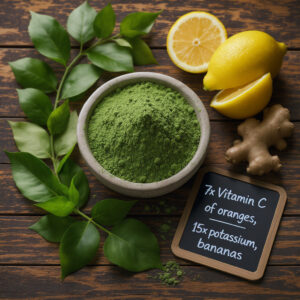Moringa is a nutrient dense plant native to parts of Africa and Asia, often called the “miracle tree” because nearly every part from leaf to seed offers therapeutic nourishment. I call it my daily dose of grounded glow. It’s rich, earthy, and surprisingly powerful… all from one humble tree.
What is Moringa? A Plant with Roots in Soil & Story
Picture this: dusty roads in South Africa, women’s hands tending green leaves under golden light. That’s where most of my moringa comes from women-led co-ops growing wisdom in leaf form.
Moringa oleifera is a fast-growing, drought-resistant tree native to the Himalayan foothills but flourishes across East and South Africa. Traditionally used in Ayurvedic practices and African folk medicine, moringa has long been a sacred ally in healing and eating. What may look like delicate green leaves actually pack more iron than spinach and more vitamin C than oranges.
Its earthy, spinach-meets-matcha flavor lingers gently on the tongue. When dried and powdered, moringa becomes the perfect companion to oat milk lattes, green smoothies, or sipped simply in hot water. One scoop. One ritual. One glow.
Why Is It Called the “Miracle Tree”?
This nickname didn’t come from a marketing deck it came from communities who survived, nourished, and healed thanks to this tree.
- Edible Everything: Leaves, pods, flowers, and even roots have use medicinal or culinary. Moringa seeds can even purify drinking water.
- Rich in Nutrients: Just one tablespoon of dried moringa leaf powder contains:
- 2g protein
- 19% daily value of vitamin B6
- 17% iron
- 10% vitamin C
- Calcium, magnesium, and antioxidants
- Deeply Restorative: Nourishes energy, supports digestion, helps fight inflammation all without the jittery buzz of caffeine.
- Resilient Growth: Moringa thrives in harsh climates, making it a food security hero in many developing regions.
Here’s how moringa stacks up against some everyday greens I keep on hand:

| Green | Iron (per 100g) | Vitamin C | Protein | Taste Profile |
|---|---|---|---|---|
| Moringa (dried leaf) | 4 mg | 17.3 mg | 27.1g | Earthy, nutty, slightly bitter |
| Spinach (raw) | 2.7 mg | 28.1 mg | 2.9g | Mild, slightly sweet |
| Kale (raw) | 1.5 mg | 93.4 mg | 4.3g | Bold, peppery |
Is moringa safe to take daily?
Absolutely. I sip on it like tea or blend it with fruit in my morning ritual. One teaspoon a day is a beautiful place to start.
What does moringa taste like?
To me, it tastes like the earth after a rain a little nutty, slightly green, faintly bitter. Add citrus, berry, or honey to mellow it out, if you’re new to it.
Can children or elders take moringa?
Yes, in moderated amounts. Talk to your family care provider if they have specific needs, but moringa’s been trusted across generations.
Where can I buy high-quality moringa?
Look for organic, shade-dried moringa powder from women-owned or fair-trade farms. Local shops, herbal apothecaries, or my Herbal Ritual Shop are great places to start.
Whether you’re looking for a deeper glow or a gentler pace for your mornings, moringa meets you there. Sip it slow. Stir with intention. Root into the ritual. Taste the green. Feel the shift.

